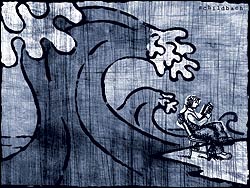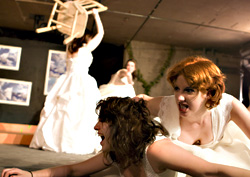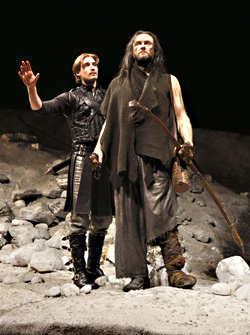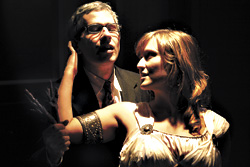We have seen the future, and it wants to kill us. That’s how it looks, anyhow, thanks to the increasingly popular view of the past as a chronicle of disasters unforetold but colorfully retold in a string of ubiquitous books. It’s an indication of society’s new catastrophe consciousness that we instinctively refer to the publishing trend as a “flood” of disaster books or, last year, as a “tsunami,” which seemed a metaphor both more dramatic and timelier, until New Orleans.
If we’re to believe Mike Davis’ new real-life horror story, The Monster at Our Door: The Global Threat of Avian Flu, made timelier by last week’s front-page news about the decoding of the 1918 flu virus that killed as many as 100 million (or more than 5 percent of humanity), and its close relation to today’s avian flu virus, perhaps the most up-to-date metaphor would be an “epidemic” of disaster books.
Why are these dismal accounts so popular? Partly, it’s because they reached a Gladwellian tipping point, so publishers plunged into the eye of the profit storm. “Publishers kind of chase what works,” says Rick Simonson of Elliott Bay Book Co. In the late ’90s, storms were working nicely, inundating the best-seller lists. The Perfect Storm roared out of the Eastern Seaboard and became an uncontrollable cliché, and Into Thin Air catapulted a Seattle freelancer into stratospheric tax brackets. “There were sea ones, mountain ones, flood ones, storm ones,” Simonson recalls. Seattle’s Erik Larson scored in 1999 with Isaac’s Storm: A Man, a Time, and the Deadliest Hurricane in History, about the 1900 destruction of Galveston, Texas, by a storm and tidal surge. Last December’s tsunami was a boon to Dennis Powers’ account of the 1964 Crescent City, Calif., tsunami, The Raging Sea: The Heroic Story of America’s Worst Tidal Wave, which was abruptly resubtitled The Powerful Account of the Worst Tsunami in U.S. History, published far ahead of schedule, and distributed in torrents to bookstores.
John M. Barry didn’t do quite as well at first with his 1999 Rising Tide: The Great Mississippi Flood of 1927 and How It Changed America, but this year, the shocking news of Bush’s contemptuous cruelty to poor black victims of Katrina propelled his book into Amazon’s top 10 and got him on NPR and Meet the Press, thanks to his horrifying portrait of hundreds of thousands of black Americans confined to refugee camps for months by Bush’s 1927 doppelgängers. Then the avian flu news hit, and Barry got another gust of success for his The Great Influenza: The Epic Story of the Deadliest Plague in History (the definitive 1918 pandemic book), soon to have a sequel in a city near you!
“Christopher Hollowell’s Holding Back the Sea: The Struggle for America’s Natural Legacy on the Gulf Coast never came out in paperback, I’m guessing,” says Simonson. “It kind of got lost in hardback.” Now the paperback is on its way, with its prescient argument on behalf of wetlands. Also coming early next year: the first big Katrina book, The Great Deluge, by rising young historian Douglas Brinkley. New Orleans native Michael Lewis is said to be penning his own, presumably nonfiction New Orleans tome, though there’s no telling whether it’s calamity-centric or more culturally and nostalgically oriented.
 Mount St. Helens, May 18, 1980: a disaster close to home. (Getty Images / Craig Mitchelldyer) Mount St. Helens, May 18, 1980: a disaster close to home. (Getty Images / Craig Mitchelldyer) |
Not even novels are immune to today’s disaster-mindedness. “Reading the paperback of Kim Stanley Robinson’s Forty Signs of Rain the week after Hurricane Katrina was eerie,” says former Amazon editor Ron Hogan. “I knew that the novel hinged upon the efforts of D.C. scientists and lobbyists to force the government’s hand on global warming issues, but I had no idea that its climax was going to be the arrival of a massive storm system which overflowed the Potomac and turned the streets of Washington into rivers. Some of Robinson’s descriptions of the storm’s impact seemed a little tame in light of what we’d just seen on TV, but other scenes—like the evacuation of the animals at the National Zoo—felt vividly authentic. I can’t wait to see how he plays out the aftermath in the upcoming sequel, Fifty Degrees Below.
“Science fiction has always had an apocalyptic streak running through it,” Hogan continues, “but there’s usually a sense that if we just listen to the scientists, everything will turn out OK. Robinson’s latest story seems to have that optimism, but there’s also a hint of fatalism, too—as if to say that things have just about hit the breaking point, and we’re going to have to start performing triage just to keep things going.” It’s a mind-set influenced by such apocalyptically inclined nonfiction best sellers as Jared Diamond’s Collapse: How Societies Choose to Fail or Survive and books more targeted to the intellectual elite, like Ross Gelbspan’s Boiling Point: How Politicians, Big Oil and Coal, Journalists and Activists Are Fueling the Climate Crisis—And What We Can Do to Avert the Disaster, which scores a trendy-cataclysm twofer by warning that the greenhouse effect is about to cause not only tragedies involving too much (and too little) water, but epidemics of malaria, dengue fever, and nasty allergies.
My favorite chapter in Gelbspan is called “Criminals Against Humanity.” Bullshit, retorts Michael Crichton, who’s switched from making millions by warning of Andromeda Strain epidemics to pooh-poohing the very idea of global warming in his 2004 best seller State of Fear, which Skeptical Inquirer reviewer Chris Mooney called “pure porn for deniers of global warming, in much the way that fictional accounts of UFO-abduction skeptics converting into true believers titillate UFO fans.” The U.S. Senate, now run by right-wing loonies very like UFO fanatics, just called Crichton to testify against global warning for its Committee on Environment and Public Works. “What planet is Michael Crichton living on? Because this one is clearly getting warmer,” wrote Mooney.
One thing is clear: On Planet Publishing, nothing is hotter than visions of apocalyptic horror. Simon Winchester, who won cult fame as a biographer of scientific eccentrics (The Professor and the Madman, The Map That Changed the World), has hopped the calamity wave in Krakatoa: The Day the World Exploded, August 27, 1883 and his latest, A Crack in the Edge of the World: America and the Great California Earthquake of 1906 (see review and interview, p. 77). He’s got competition in Philip L. Fradkin’s new The Great Earthquake and Firestorms of 1906: How San Francisco Nearly Destroyed Itself and resurfacing older books like Malcolm Barker’s 1998 Three Fearful Days: San Francisco Memoirs of the 1906 Earthquake & Fire.
Though as many books as possible come with subtitles like “The Deadliest Fire in America’s History,” even less celebrated natural disasters are finding themselves newly marketable. There are recent books about the New Madrid earthquake of 1811 (also cited in Winchester’s new book), the Florida Labor Day hurricane of 1935, the Mill River flood of 1874, the Dayton Flood of 1913, and the Martinique volcano of 1902.
The New York Times Book Review‘s Sara Mosle left her plum perch to write a book about a 1937 school explosion in New London, Texas; she’s a superb and ambitious writer, and this may be her best shot at a best seller. There are two competing accounts of the 1928 Everglades hurricane, and local true-crime writer Gregg Olsen, who has switched from Mary Kay Letourneau and company to surf the catastrophe wave, may find his book The Deep Dark: Disaster and Redemption in America’s Richest Silver Mine (about Idaho’s 1972 Sunshine Mine fire) slugging it out with Voices of the Knox Mine Disaster: Stories, Remembrances and Reflections on the Anthracite Coal Industry’s Last Major Catastrophe, Jan. 22, 1959, by Robert, Nicole, and Kenneth Wolensky. Also close to home, there’s Frank Parchman’s Echoes of Fury, about the May 18, 1980, Mount St. Helens eruption.
One of your better disaster values, in terms of how many disasters you get packed between two covers, could be Ernest Zebrowski Jr.’s Perils of a Restless Planet: Scientific Perspectives on Natural Disasters, which boasts the Johnstown flood of 1889, the Lisbon earthquake of 1755, the plague of 1347, the Kobe earthquake of 1995, the Santorini volcano of 1600 B.C., and sundry others.
Many readers find inspiration in tales of the human spirit tested by natural calamity, the storms and plagues that strike us without warning, but I prefer stories of disaster caused by human stupidity. Tom Waldron’s Pride of the Sea: Courage, Disaster, and a Fight for Survival is clearly aimed for the spiritual-uplift market, but it sounds irresistible to me: Apparently, the death of the poorly trained occupants of a boat in 1986 resulted when the craft, a replica of a War of 1812 schooner designed for use in Baltimore’s Inner Harbor, was reassigned to tour the sea promoting Baltimore. Somebody decided not to alter it for real seagoing conditions, and it wasn’t submitted for inspection by the Coast Guard. It sailed for nine years and predictably sank.
Better yet is Diamond’s contention in Collapse that the 15th-century Nordic settlers of Greenland starved to death among plenty by stubbornly sticking to a cow-based diet, despite the fact that the cows were freezing and fish could literally be plucked by hand from the water, as the Greenland natives did right before their eyes. But they weren’t going to behave like a pack of aborigines. Being Norwegians, they didn’t see any reason why they should change.
Ultimately, nobody really reads disaster books to prepare for Earth’s next inevitable catastrophe. Pragmatic books like Keith Smith’s Environmental Hazards: Assessing Risk and Reducing Disaster and Eric Noji’s The Public Health Consequences of Disasters rank No. 558,871 and No. 299,341, respectively, on Amazon’s best-seller list. Marc Siegel’s False Alarm: The Truth About the Epidemic of Fear does better at No. 3,125, but readers aren’t really eager to hear his message: that we’re so panic-stricken we overreact to disasters that never materialize (West Nile, anthrax, SARS) and fail to deal with the ones that really are fixing to kill us (obesity, heart disease, cancer, diabetes). He says we worry too much about avian flu’s unlikely reprise of 1918, and that, in any case, panic increases an epidemic’s deadliness by sparking disease-fueling stampedes.
Maybe. On the other hand, the Centers for Disease Control and Prevention estimate that even another outbreak of the milder 1968 pandemic flu virus could kill six times as many Americans, thanks to medical advances that give us more old people, chemotherapy and HIV patients, and others with compromised immune systems. Some 40 million Americans lack health insurance, and the government is controlled by nut jobs who don’t believe in federal help to the needy, nor in evolution (of which flus are proof), nor in the global warming that fuels Gulf Coast hurricanes, nor in plate tectonics (if the Earth is now exactly as God made it then). The most terrifying new book out there, in my opinion, is Chris Mooney’s The Republican War on Science.
We should be afraid, very afraid, and our choice of reading reflects that. Even if our government were more reality-based, it might not be able to do enough to save us from the innumerable Armageddons heading our way. But it sure would be nice to know that our leaders had a clue. Bush stubbornly refuses to read newspapers, but perhaps some loyal aide might be willing to read to him from the burgeoning literature of disaster.








